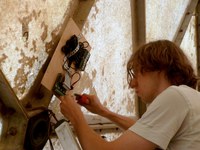First Ambisonics and discrete sound Experiments in the dome in Pischelsdorf
Intro
"A geodesic dome with 20m diameter and about 10m high as an environmental landscape sculpture in Pischelsdorf should transmute into 3D a soundsphere. Therefore as special hardware and software a low power solar power driven multichannel Ambisonics speaker system will be developed and installed. This project is commissioned by Kunstinitiave K.U.L.M. in Pischelsdorf/Styria: "eine geodätische Kuppel als Klang-Dom"
Therefore a Ambisonics system should be developed:
- It should be robust because of outdoor environment
- sounding well
- autonomous powered by solar energy
Therefore a in August 2012 a workshop to test realization of such a sytem in the dome was held. We started with first implementation of a 2D Ambisonics ring.
A short demonstration video of the outcome of the workshop.
The problem definition to solve was mainly to handle with the special acoustics in the dome, which has strong reflections and echoes, especially in the middle since the concave form. The hypothesis was to handle this was trying to use many small speakers, which are seated on the inner surface. Since each of them are low power, they should not produce to much reflections on the other side but all together enough for filling the dome.
Preperations
The system shown in the diagramm should be partly installed and tested, whereby as main controller we used our notebooks and the from the solar power station the Akkumulator was used, to see how much the system draws energy. As amplifier units we used prototypes of the escher "amp8".
System to be installed.
As speakers 50W dual cones ware used, which fit in the joints of the triangles of the dome. Also for better sound some damping material was added. 16 of them where prepared and has to be mounted. Cabling was done with standard speaker cables. Since of the harsh environment in the dome, more than 50 degree in summer and a micro-climate which produces a kind of local rain inside on rainy days up to -20 degree Celsius in winter, the hardware should be robust. Any way this first version should stay for half a year to observe the behaviour.
For the placement of the speakers, we used the hexagonal and pentagonal joints, stuffed with damping material to reduce resonances. Also hexagonal and pentagonal joints has to be used. In a first test we have chosen the lower ring.
The first prototypes of the 8 channel 25W class-D Amplifiers has been equipped for the first test with 8-channel USB/DA-boxes instead of the 24bit DA on board, because he needs an escher-board to be driven, which was not stable at the moment of this tests, but the development of this hardware within the escher series is another story.
As software we used the CUBEmixer Library rendering the 2D-Ambisonics within the software framework for ICE, the IEM Computermusic Ensemble.
The first audio tests for the Ambisonics installation in the dome was an adaption of the piece Vacation Teleport, lately performed by the IEM Computermusic Ensemble. The idea was to enable a single musician exploring the acoustics and the spatial possibilities of the Ambisonics playback system within the Klangdom. The system is controlled by the Nintendo WII Remote to interpret and spatialize sound samples in musical ways.
The wireless controller allows to move around freely in the dome which is very handy for exploring the different acoustic situations depending on the listeners position.
With a 12V power system for the amplifiers, we could play all the time with one full battery, even having good loud sound inside. Of course this is because of the acoustics wwith a weak absorbtion and also not forcing for low sounds, which would need a subwoofer anyway. But for playing field-recordings it works quite well.
Result
One result of the workshop has been, generally the Hypothesis work. Even in this extreme situation a Ambisonics spatial reception was given. It does not sound very neutral nor linear and at some places there are still resonances and wrong spatial receptions, but the sweet spot was good enough to play. It would be better if there are more audience in the room to lower reverberation and spacious sounds works better than dry ones, which is good for field-recording material.
afterword
Last but not least we found it very exciting to work on these and a relax after living in the K3 of K.U.L.M. , an old shoe manufactory and afterword relaxing and discussing the output in the field studios in Pichla, a expositiur of atelier algorythmics.
Also big thank for the hospitality at Pischelsdorf especially family Frankenberger which offered us the space and help to work.

















